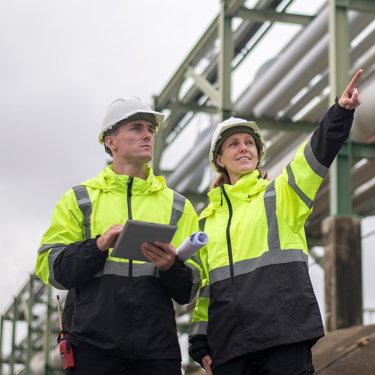Understanding and addressing pluvial flooding: A path towards resilient urban futures
Published: 25 March 2025
According to research, 4.6 million UK properties are at risk from pluvial flooding – also known as surface water or urban flooding – making this a pressing issue for cities worldwide.
Unlike fluvial flooding caused by rivers overflowing, pluvial flooding occurs when intense rainfall overwhelms drainage systems or falls on impervious surfaces, leading to devastating consequences. With climate change exacerbating extreme weather events, understanding pluvial flooding and implementing effective mitigation strategies is more critical than ever.

This article explores the causes, impacts and solutions for pluvial flooding, drawing on insights from experts and highlighting the urgent need for sustainable urban development to protect communities and infrastructure.
The causes of pluvial flooding
Pluvial flooding arises from several interrelated factors:
- Intense rainfall: Climate change has increased the frequency and severity of extreme rainfall events. Warmer air holds more moisture, leading to heavier downpours.
- Urbanisation: Cities are dominated by impervious surfaces like asphalt and concrete, which prevent water from infiltrating the ground. This rapid run-off often overwhelms drainage systems.
- Ageing infrastructure: Many drainage systems were designed for historical rainfall patterns and are now inadequate for modern climate realities.
- Overloaded sewage systems: Combined sewer systems (common in older cities) handle both rainwater and wastewater. During heavy rains, these systems overflow, compounding the flooding problem.
The impacts of pluvial flooding
The consequences of pluvial flooding extend far beyond waterlogged streets.
- Economic damage: Floods destroy property, disrupt businesses, and result in high insurance claims. For instance, the July 2021 floods in London caused damages exceeding £281 million.
- Infrastructure disruption: Roads, railways and airports often grind to a halt during floods, paralysing urban mobility.
- Health and safety risks: Flooding can lead to injuries, fatalities, and waterborne diseases.
- Community displacement: Residents are forced to evacuate, with long-term social and emotional impacts.
Pluvial flooding and climate change
Climate change is intensifying the conditions that lead to pluvial flooding. According to the National Infrastructure Commission, over 325,000 properties in England currently face a high risk of surface water flooding, a number expected to rise due to:
- Increased rainfall intensity: More frequent and severe storms will raise flooding risks.
- Urban development: New construction adds impervious surfaces, stressing drainage systems.
- Lack of mitigation measures: Unchecked development can exacerbate surface water issues.
Sponge cities: a global inspiration
Cities like Copenhagen and New York City are pioneering the concept of sponge cities, where urban planning focuses on absorbing and managing rainfall efficiently.
Copenhagen’s Cloudburst Management Plan
After a catastrophic flood in 2011, Copenhagen implemented an ambitious plan involving over 250 projects, including:
- Green spaces: Parks and green roofs to soak up rainwater.
- Stormwater tunnels: Underground systems to channel excess water to the sea.
- Public engagement: Encouraging sustainable practices among residents.
This approach, costing approximately £1.26 billion, has transformed Copenhagen into a model of climate resilience.
“Sustainable water management has never been more important in the bid to reduce flooding and improve water quality. The time to act is now.”
Jo Bradley
Chair of British Water's SuWM Focus Group
What is happening in the UK?
Severn Trent Water
Severn Trent is investing £76 million to transform Mansfield into a ‘sponge city’ through blue-green infrastructure addressing surface water flooding. This two-and-a-half-year project aims to protect 90,000 people by implementing detention basins, bioswales, rain gardens, and permeable paving across 6.5 hectares. Designed under a post-pandemic green recovery plan, it will store 30 million litres of rainwater during storms.
The initiative targets over 200 high-risk locations, with solutions tailored using advanced tools like Arup’s Terrain software and ground truthing. Severn Trent collaborates with the University of Sheffield, leveraging lessons from Sheffield’s Grey to Green project to enhance materials and designs for sustainable drainage systems (SuDS).
These nature-based solutions, although initially 11% costlier than expanding sewer capacity, reduce stormwater entering the sewer system, preventing water pollution and saving on treatment costs. They also beautify urban spaces, aligning with Mansfield’s greening plans to boost the local economy and quality of life.
The project is a first for a UK water company in scope and pace, with Severn Trent managing assets post-construction. Future plans include replicating this model in Nottingham, Coventry, Gloucester, and Kidderminster. This pioneering effort positions water companies as leaders in delivering sustainable, multi-benefit flood management solutions, demonstrating that initial investments in green infrastructure yield long-term environmental, economic, and social benefits.
United Utilities
In the north-west, United Utilities, Greater Manchester Combined Authority, and the Environment Agency have developed the UK’s first integrated water management plan. This initiative addresses flood resilience, water quality, and climate adaptation, identifying up to 300 high-risk locations for potential intervention.
Kingston-Upon-Hull, with 98% of its area at flood risk, exemplifies the challenge. Historic flooding, including the devastating 2007 rainfall and the record 5.8-metre tidal surge in 2013, spurred significant investments such as the £42 million Hull frontages flood defence scheme, protecting 113,000 properties.
Hull’s Living With Water Partnership, involving local councils, Yorkshire Water, and the University of Hull, outlines a 25-year plan to enhance drainage capacity and implement blue-green solutions. With an estimated £26.25 million allocated for these measures by 2030, Hull is evolving into a model for collaborative, sustainable flood risk management.
Solutions for tackling pluvial flooding
To combat pluvial flooding, cities need to adopt a mix of innovative and sustainable strategies.
SuDS mimic natural water cycles, incorporating solutions like permeable pavements, rain gardens, and retention basins. These systems reduce run-off and enhance water infiltration.
Upgrading outdated drainage networks is essential. Cities must invest in larger pipes, additional stormwater reservoirs, and better sewage management systems.
Legislation plays a vital role. Implementing Schedule 3 of the Flood and Water Management Act in England, for instance, would mandate sustainable drainage for new developments.
Expanding urban green spaces and reducing impermeable surfaces can help cities absorb more rainfall and reduce run-off.
Advanced climate models and digital simulations can identify vulnerabilities in urban water management, enabling planners to design adaptive, future-proof solutions.
Recommendations for action
To make meaningful progress, collaboration across sectors and communities is crucial. The following steps are recommended.
Policymakers must prioritise integrating SuDS into urban planning. For example, British Water has urged the government to make sustainable drainage systems mandatory for new developments.
Water companies, such as Severn Trent, are taking proactive roles in flood management. Their catchment-based solutions provide a template for other regions.
Public awareness campaigns can encourage residents to adopt flood-resistant measures, such as reducing paved surfaces and incorporating greenery in their homes.
Learning from global leaders like Copenhagen and New York City can accelerate innovation and knowledge-sharing in flood resilience.
The cost of inaction
The financial burden of pluvial flooding is staggering. England’s annual cost of surface water flooding incidents is estimated at billions, not to mention the environmental and societal toll. Without action, the frequency and severity of these events will only escalate, straining already limited resources.
Towards resilient urban futures
Building resilient cities requires a fundamental shift in how we manage water and plan urban spaces. By adopting nature-based solutions, upgrading infrastructure, and fostering community involvement, we can mitigate the devastating effects of pluvial flooding.
As Jo Bradley, chair of British Water's SuWM Focus Group, aptly notes: "Sustainable water management has never been more important in the bid to reduce flooding and improve water quality. The time to act is now."
Through collaboration, innovation, and commitment, we can transform our cities into resilient, adaptive spaces ready to weather the storms of a changing climate.
This white paper underscores the urgency and opportunity to address pluvial flooding. By harnessing international best practices and adopting forward-thinking strategies, cities can pave the way for sustainable, flood-resilient futures.
Latest resources
 Case study
Case studyAssessing New Zealand’s hydrogen feasibility as part of their journey towards a decarbonised future
 Case study
Case studyUnlocking the potential of biomethane for South West Water
 Insights
InsightsSerious gaming: A solution to long-term planning in the water sector
 White paper
White paperUnderstanding and addressing pluvial flooding: A path towards resilient urban futures
Environmental compliance today, creating a sustainable tomorrow
Helping you reduce risk to the environment and your operation by managing assets compliantly while achieving commercial, ESG, and net-zero goals.
Contact our experts

